Keeping Your Teeth Clean
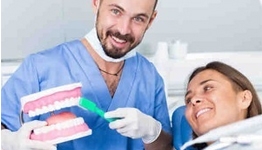
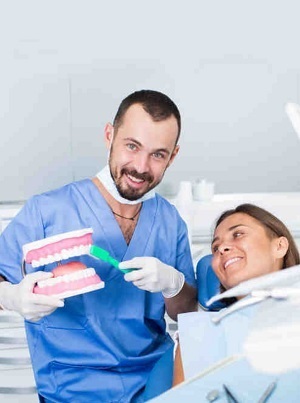
Good Dental Hygiene + Orthodontics = A Smile That’s Good for Life®
It’s important that you take good care of your teeth during Orthodontic treatment. By brushing and cleaning in between your teeth regularly, you’ll keep your teeth and gums in top condition and ensure that your orthodontic treatment will deliver the healthiest, most beautiful smile possible. When your braces come off, you’ll see that your extra efforts have been rewarded with a healthy, greatlooking smile that’s good for life.
Successful orthodontic treatment - a healthy and beautiful smile - is the result of a team effort between you, your orthodontist and your dentist. You as the patient play the key part. Most importantly, you must keep your teeth, gums and braces clean while you are in orthodontic treatment. Proper dental care will take a little extra time and effort, but it is well worth it. Closely follow the instructions your orthodontist and staff members give you.
When to Brush
You should brush your teeth thoroughly after every meal or snack. If you can’t brush right away after a meal, be sure to at least rinse your mouth well with water until you can brush. Carry a travel toothbrush so that you can brush when away from home. At least once every day, clean between your teeth, then brush your teeth and braces thoroughly until they are spotlessly clean. The best time of the day to thoroughly clean your teeth and braces is at night, before you go to bed.
How to Brush
Use a fluoride toothpaste and a soft, end-rounded bristle toothbrush or power toothbrush that’s in good condition. Your toothbrush or power toothbrush head should be changed frequently since the brackets on your teeth will quickly wear out the bristles. Toothbrushes and power toothbrush heads should be changed at the first sign of wear or at least every 3 months.
Brush around all the parts of your braces and every surface of your teeth - fronts, sides, and backs and chewing surfaces for at least 2 full minutes. Be sure to brush your tongue and roof of the mouth, too.
A good way to tell if you’re brushing correctly is if your braces look clean and shiny and you can see the edges of the brackets clearly
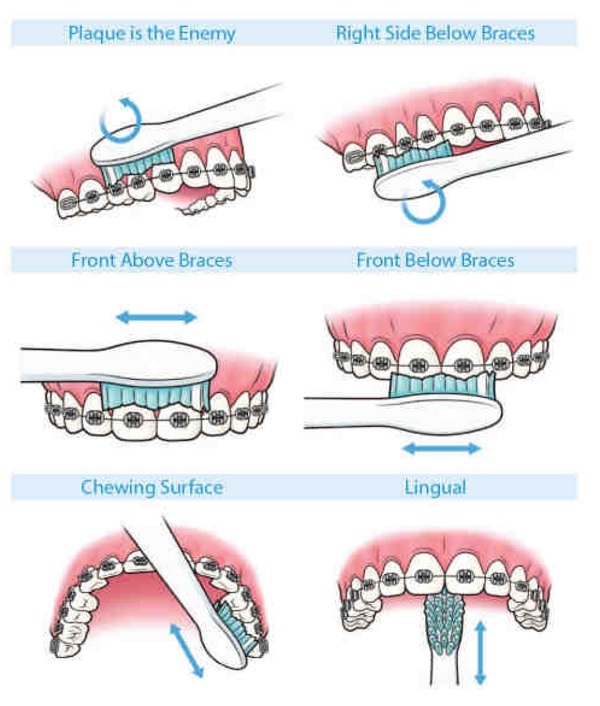
Brush your gums gently and thoroughly. Rinse thoroughly after brushing with water or a mouth rinse recommended by your orthodontist. Inspect your teeth and braces regularly and carefully to make sure they are spotless.
Look closely in a well-lighted mirror. This is a good time to check for loose or broken brackets. If you find a problem, contact the orthodontist’s office to see if it needs to be checked out and if time needs to be scheduled to make a repair.
How to Clean Between Your Teeth
Floss every night before you go to bed. If you use regular floss, it might be necessary to use what’s called a floss threader
This reusable tool allows you to get dental floss underneath your archwires easily. Another more convenient option is pre-threaded floss. Either way, be sure you clean carefully along and under the gum line. And as with anything, a little practice will make it go a lot easier. If necessary, supplement flossing with an interproximal brush.
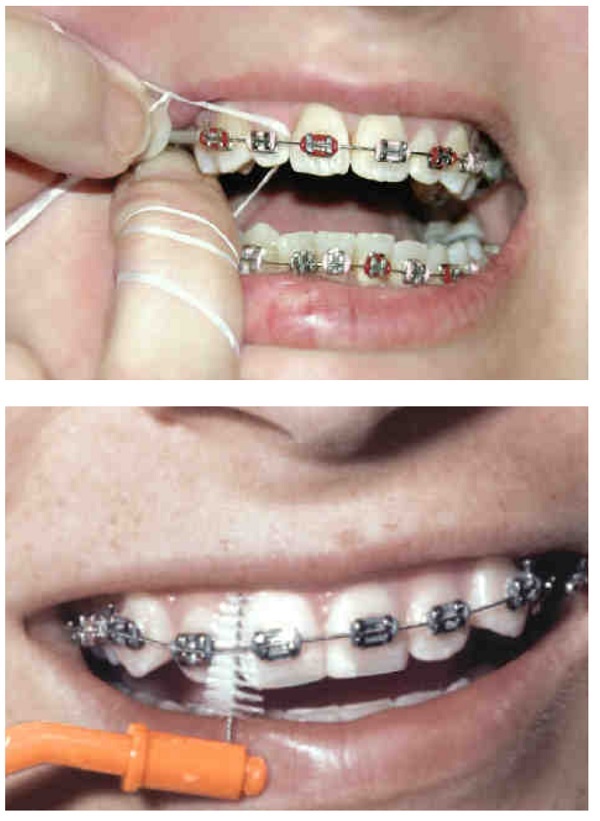
How long does treatment take?
Orthodontic treatment averages less than two years, but can range from one to three years. When “active” treatment ends, retainers are prescribed for most patients to keep teeth in their new positions.
How much does treatment cost?
Floss every night before you go to bed. If you use regular floss, it might be necessary to use what’s called a floss threader.
This reusable tool allows you to get dental floss underneath your archwires easily. Another more convenient option is pre-threaded floss. Either way, be sure you clean carefully along and under the gum line. And as with anything, a little practice will make it go a lot easier. If necessary, supplement flossing with an interproximal brush.
Other Hygiene Helpers
Your orthodontist may recommend one or more of these aids to help keep your teeth clean:
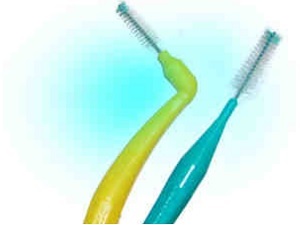
Interproximal brush
This tool slips under your arch wire to help you remove plaque and food particles around your brackets and between teeth. There are varying sizes of interproximal brush heads available so choose a size that matches the space between your teeth.
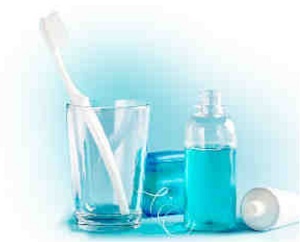
Fluoride toothpaste or fluoride rinse
Use a fluoride toothpaste as part of your cleaning routine. For the best results, use a fluoride rinse with your interproximal brush to deliver maximum fluoride protection to your teeth.
protection to your teeth. Your orthodontist may recommend daily use of a prescription fluoride toothpaste or fluoride rinse.
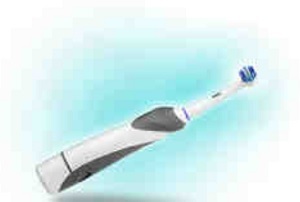
Power toothbrush
These devices are designed to make brushing easier and more efficient. Ask your orthodontist if a power toothbrush would be helpful during your treatment.
The Problems That Poor Oral Hygiene Can Cause Good dental hygiene is critical during orthodontic treatment. Without it, plaque and food can accumulate around your braces. The bacteria in plaque react with sugars and starches in food you eat and form an acid that can eat away the enamel on your teeth leading to permanent white marks, cavities or gum disease.
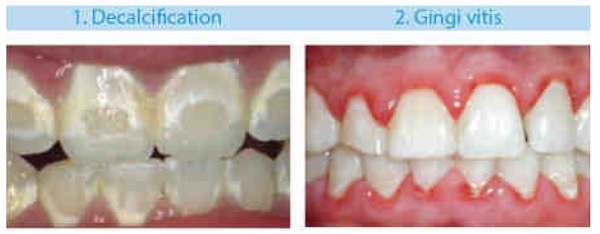
Early gum disease is reversible with professional help and good home care, but if it’s ignored it can get worse. Gum disease is usually painless, so you need to pay attention to signs like bleeding, or swollen and puffy gums. Carefully follow all your orthodontist’s directions to avoid these problems.
- The white marks left on your teeth around your braces are called decalcification and these marks will remain on your teeth for life. The best way to avoid decalcification is to not let it develop at all.
- Periodontal (gum) disease, caused by the buildup of plaque, occurs in three stages. In the first stage, plaque accumulation irritates the gums. Your gums may be red, puffy or swollen. They may bleed when you brush or floss. This infection is called gingivitis.
- Over time, infection and inflammation in the gums can spread to the ligaments and bone that support the teeth. The gums start to pull away, forming gaps or pockets between your teeth and allowing more plaque to accumulate. This disease is called periodontitis.
- Pockets of bacteria can form and deepen beneath your gums, attacking and destroying the bone that anchors your teeth in place. This can cause healthy teeth to loosen or eventually fall out. This disease is called advanced periodontitis.
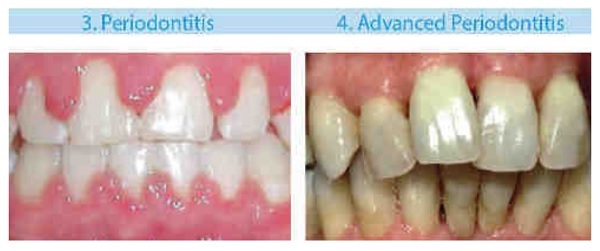
Foods/Actions to Avoid

Avoid sugary, crunchy, sticky, chewy and hard foods that can break your braces.
Eating ice, chewing on pencils or pens and biting into whole apples can cause loose and/or displaced brackets and bent archwires. Refrain from these actions during your orthodontic treatment.
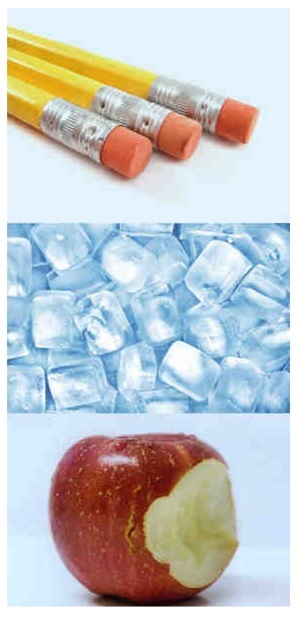
Partnership: You, Your Orthodontist and Your Dentist.
Achieving healthy, beautiful smiles is a team effort that involves your orthodontist, your dentist and you, the patient. Your orthodontist provides the expertise, the treatment plan and the techniques to straighten teeth and align the jaws. Your dentist helps make sure that teeth and gums stay clean and healthy. As the patient, you must cooperate by following your dentist’s and orthodontist’s instructions carefully so that your teeth and jaws move in the way desired and on the prescribed schedule.
Because dental hygiene is so important, regular visits to see your dentist must continue every six months during your orthodontic treatment (or more often, if recommended). It is essential that you avoid hard, sticky, crunchy or chewy foods which may damage orthodontic appliances. You must also maintain a healthy, nutritional diet to achieve the best possible results from treatment. A good diet provides essential nutrients to bones and tissues undergoing change during orthodontic treatment.

Orthodontists receive an additional two to three years of specialized education beyond dental school to learn the proper way to align and straighten teeth. Only those who successfully complete this formal education may call themselves “orthodontists,” and only orthodontists can be members of the American Association of Orthodontists.
If you have any questions or concerns throughout your treatment or in the future, please consult your orthodontist.



